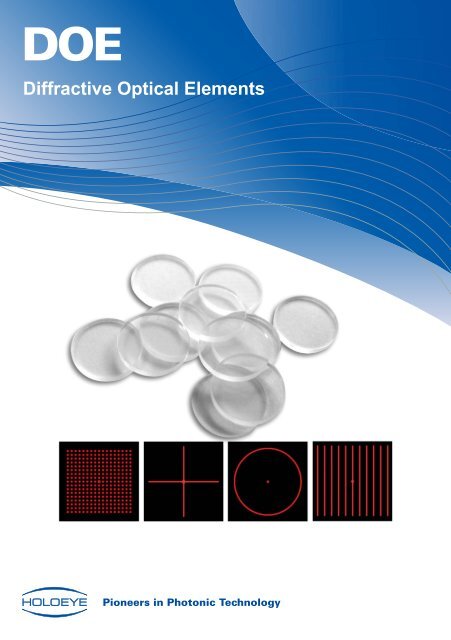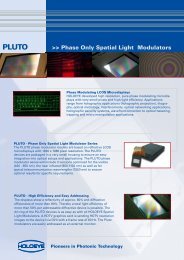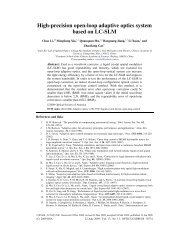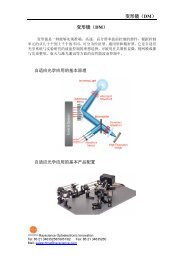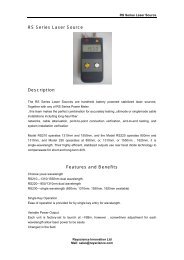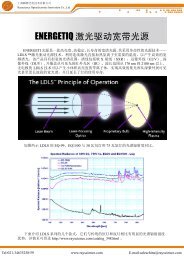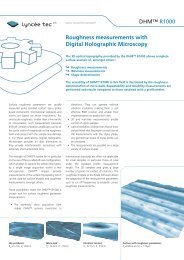Diffractive Optical Elements
Diffractive Optical Elements
Diffractive Optical Elements
You also want an ePaper? Increase the reach of your titles
YUMPU automatically turns print PDFs into web optimized ePapers that Google loves.
DOE<br />
<strong>Diffractive</strong> <strong>Optical</strong> <strong>Elements</strong>
Functionality of <strong>Diffractive</strong> <strong>Optical</strong><br />
<strong>Elements</strong><br />
A <strong>Diffractive</strong> <strong>Optical</strong> Element (DOE) utilizes a surface<br />
with a complex microstructure for its optical function. The<br />
micro-structured surface relief profile has two or more<br />
surface levels. The surface structures are either etched<br />
in fused silica or other glass types, or embossed in<br />
various polymer materials.<br />
Far-Field Diffraction Pattern<br />
Problem Analysis & Feasibility Studies<br />
The first step is the work towards a specification that<br />
contains all relevant parameters. In some cases, a<br />
feasibility study is required. HOLOEYE offers a range of<br />
off-the-shelf diffractive optical elements. Proof-of-concept<br />
experiments with these elements are often helpful for the<br />
derivation of the specification. In addition, as a supplier of<br />
spatial light modulator (SLM) technology, HOLOEYE also<br />
has the capability to demonstrate optical functions of<br />
DOEs experimentally using SLM devices as switchable<br />
optical elements.<br />
<strong>Diffractive</strong> <strong>Optical</strong> Element<br />
Laser Beam<br />
DOE Surface Relief Profile<br />
Properties of <strong>Diffractive</strong> <strong>Optical</strong><br />
<strong>Elements</strong><br />
The different types of DOEs (beam splitters, Fourier<br />
holograms, beam shapers, diffusers and various grating<br />
structures) act like optical processors, splitting or<br />
reshaping light to almost any desired distribution.<br />
Additionally, diffractive optics can realize almost the<br />
same optical functions as refractive optics such as<br />
lenses, prisms or aspheres, but they are much smaller<br />
and lighter. DOEs are not limited to laser applications;<br />
partially coherent light from LEDs or other light sources<br />
can also be modulated.<br />
Steps towards the solution:<br />
System analysis<br />
Feasibility studies<br />
Experimental investigation with HOLOEYE<br />
DOE standard products or SLMs<br />
Custom design of diffractive elements<br />
according to customer specifications<br />
Fabrication of prototypes<br />
Tooling for DOE replication<br />
Replication of diffractive elements<br />
<strong>Optical</strong> performance tests<br />
Design & Simulation of <strong>Diffractive</strong><br />
<strong>Optical</strong> <strong>Elements</strong><br />
HOLOEYE uses computational design methods like<br />
Iterative Fourier Transform<br />
Algorithms (IFTA), direct<br />
binary search (DBS)<br />
algorithms, gradient<br />
search algorithms and<br />
methods based on the<br />
determination of geometrical map transformations. We<br />
can design DOEs for patterns on inclined surfaces and<br />
with arbitrary angles of diffraction. This allows us to<br />
precisely place diffraction spots freely on a target surface.<br />
The obtained element design will be verified in scalar or<br />
rigorous wave-optical simulations prior to fabrication.<br />
Fabrication of DOEs<br />
The fabrication technology should be carefully chosen<br />
depending on the specification and the target production<br />
volume. Fabrication options include<br />
(A) High-quality fabrication by lithography for single pieces<br />
or low element numbers<br />
(B) High-precision low-volume to medium-volume<br />
replication<br />
(C) High-volume low-cost replication<br />
First the design data is optimized for minimum fabrication<br />
error dependency. The<br />
lithography technology<br />
will be chosen to meet<br />
specifications on the one<br />
hand and to minimize<br />
cost on the other hand.
For diffractive structures with pixel sizes down to 50nm, it is<br />
necessary to use e-beam direct writing lithography. For<br />
diffractive structures with more coarse structures (feature<br />
sizes >1µm) the necessary resolution can be reached with<br />
laser lithography and a shorter writing time.<br />
After the sequential writing process, etching techniques like<br />
reactive ion etching or ion<br />
milling are used to create<br />
surface relief structures in<br />
the substrate material. With<br />
electroplating it is possible<br />
to generate tools for<br />
replication processes like injection molding or nanoimprinting<br />
The fabrication of a master component with an optical<br />
microstructure can be very costly. Therefore, replication<br />
technologies represent a major economic success factor in<br />
diffractive optics, because replication significantly reduces<br />
the cost of each single optical element.<br />
HOLOEYE offers high-precision replication of small<br />
quantities for applications in<br />
technical optics at reasonable<br />
cost. Replication is<br />
possible in many different<br />
materials in order to account<br />
for:<br />
Different substrate materials and shapes<br />
Variation of light source wavelength (e.g. for ensuring eye<br />
safety)<br />
Different environmental conditions (temperature, humidity)<br />
We need to know the following parameters<br />
for the development of your customized<br />
DOE:<br />
Light Source:<br />
Type (cw laser, pulsed laser, LED, other),<br />
Wavelength (center and bandwidth)<br />
Polarization<br />
Power/Energy (average and/or peak)<br />
Beam profile (diameter, divergence, M² quality)<br />
<strong>Optical</strong> Function:<br />
Desired light field distribution (shape, uniformity)<br />
Working distance<br />
Field of view / Diffraction angles<br />
Target surface inclination and/or shape<br />
Application:<br />
Eye Safety requirements<br />
Element form factor (size, shape)<br />
Element material<br />
Environmental conditions<br />
Packaging of elements<br />
Sensor and/or screen type for light field (CCD/CMOS/ human<br />
eye/…)<br />
Last but not least, the target annual production and a price<br />
target are required to choose the best solution.<br />
DOE<br />
Laser Module<br />
For high-volume applications, the price of the optical<br />
component can be lowered by injection molding technology.<br />
Based on our experience, we are commited to make a<br />
competitive offer for your high-volume applications while<br />
still meeting the quality requirements and are willing to<br />
adapt our handling and packaging procedures to fit with<br />
your assembly processes.<br />
Application Example<br />
The diffractive optical elements are delivered in the<br />
customers’ requested shape and size and optionally can be<br />
integrated with a customized mechanical holder.<br />
Quality Assurance and Implementation<br />
Support<br />
After fabrication, HOLOEYE will validate the compliance of<br />
the DOEs with the specification<br />
experimentally. When<br />
replicating elements in larger<br />
numbers, optical key<br />
properties will be monitored<br />
using automated equipment.<br />
Upon customers´ request, we are ready to visit the<br />
customer´s laboratories and provide assistance regarding<br />
the actual implementation of the DOE into the customer´s<br />
system.
HOLOEYE Photonics AG<br />
Albert-Einstein-Str. 14<br />
12489 Berlin, Germany<br />
Phone: +49 (0)30 6392 3660<br />
Fax: +49 (0)30 6392 3662<br />
saleschina@rayscience.com<br />
www.rayscience.com<br />
HOLOEYE Corporation<br />
1620 5th Avenue, Suite 550<br />
San Diego, CA 92101, USA<br />
Phone: (888) 446-5639, ext. 110<br />
Fax: (888) 446-5639<br />
saleschina@rayscience.com<br />
www.rayscience.com<br />
SLM DOE– Rev. 1.1 1.0 – Specifications are subject to change without notice


